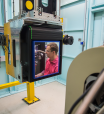Gold Standard for Conferences
ANSTO’s commitment to Diversity and Inclusion extends to all events we host or conferences we support through sponsorship, expertise (presenting/speaking) or staff attendance as delegates.

Showing 201 - 220 of 431 results
ANSTO’s commitment to Diversity and Inclusion extends to all events we host or conferences we support through sponsorship, expertise (presenting/speaking) or staff attendance as delegates.
A large international team led by scientists from the Institute for Superconducting and Electronic Materials at the University of Wollongong has verified that the introduction of novel molecular orbital interactions can improve the structural stability of cathode materials for lithium-ion batteries.
3D models of multilayered structures on engineering scale from nanoscale damage profiles.
A world-first processing technology developed in collaboration by ANSTO’s Minerals unit.
Tool developed for producing F-18 radiopharmaceuticals for PET imaging.
Testing at ANSTO’s Centre for Accelerator Science supports an action plan just published by the Australian Packaging Covenant Organisation (APCO) to phase out per- and polyfluoroalkyl substances (PFAS) in fibre-based food contact packaging in Australia by December 2023.

ANSTO is responsible for the Little Forest Legacy Site (LFLS) located within the ANSTO Buffer Zone boundary. This site, formerly known as the Little Forest Burial Ground (LFBG), was used by the Australian Atomic Energy Commission (AAEC) during the 1960’s to dispose of waste containing low levels of radioactivity and beryllium oxide (non-radioactive) in a series of shallow trenches. There has been regular monitoring of the site since 1966 and the results have been reported in ANSTO’s environmental monitoring reports.
Research on a rare type of superconducting intermetallic alloy
An unusual and very exciting form of carbon - that can be created by drawing on paper - looks to hold the key to real-time, high throughput DNA sequencing, a technique that would revolutionise medical research and testing.
The 3D structure of a fungal and plant enzyme solves 50-year-old mystery.
First publication from PELICAN and National Deuteration Facility
A new imaging technology developed at ANSTO makes it possible to image, identify and locate gamma-ray radiation in a safe and timely manner.

The High Performance Macromolecular Crystallography beamline will enable the study of very small (sub-5 micrometre) or weakly diffracting crystals, providing a state-of-the-art high-throughput facility for researchers. MX3 will be able to study the structures of large proteins and protein complexes for virology, drug design and industrial applications via goniometer mounted crystals, in-tray screening, or via serial crystallography methods.
On behalf of Australia, ANSTO, the only nuclear reactor facility in Australia, supports the International Atomic Energy Agency (IAEA) to undertake its role in facilitating national, regional, and international efforts to enhance nuclear security, including measures to protect against nuclear terrorism.
Over 250 students took part in ANSTO's annual Science and Engineering Challenge with an all-girl school taking top honours.
A rare collection of traditional Aboriginal wooden objects in varying degrees of preservation found along a dry creek bed in South Australia have been dated to a period spanning 1650 to 1830 at the Centre for Accelerator Science at ANSTO.
China’s vertical sandstone pillars studied using nuclear techniques